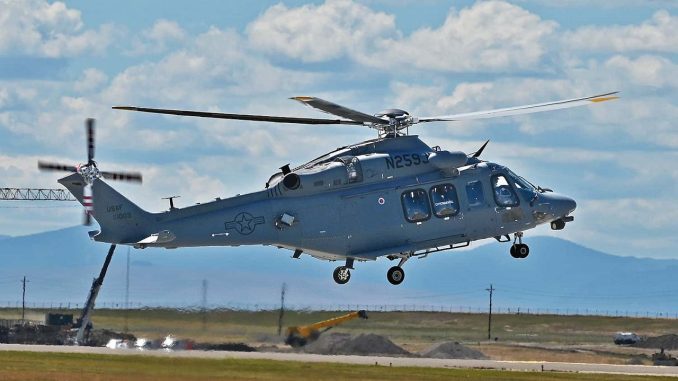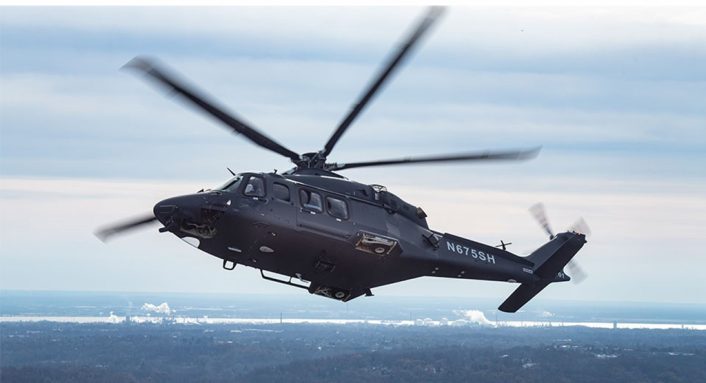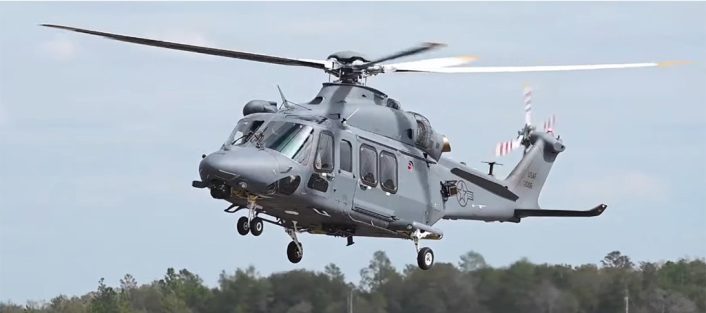
The delivery of the first MH-139A “Grey Wolf” production aircraft marks a significant milestone in modernizing the U.S. Air Force’s helicopter fleet dedicated to the safeguard of the nuclear arsenal.
On Aug. 5, 2024, Boeing has delivered the first production MH-139 Grey Wolf helicopter to the U.S. Air Force. The helicopter, which will be stationed at Malmstrom Air Force Base, Montana, and assigned to the 550th Helicopter Squadron, is part of a LRIP (Low-Rate Initial Production) order of 13 helicopters commissioned in 2023.
The MH-139 has been selected as the new platform to protect InterContinental Ballistic Missiles (ICBM) sites and to transport U.S. Government officials and Security Forces. Thanks to its advanced systems and functionalities, the MH-139 provides a valid substitution to the oldest legacy helicopters like the UH-1N which have been in service for nearly fifty years.
“This aircraft is the first production aircraft on contract and officially marks the start of low-rate production deliveries and paves the way for the Air Force to make a full-rate production decision in the future,” said Boeing. “Delivering this asset for the MH-139A fleet is critical to the future of national security as the Grey Wolf will play a crucial role in the U.S. nuclear triad for decades to come.”
The U.S. Air Force in 2024 awarded a contract for seven additional MH-139As to Boeing. With six helicopters already delivered as part of the Research, Development, Test & Evaluation (RDT&E) phase, Boeing has currently a total of 26 aircraft on contract. The first operational MH-139A, initially used as a test and evaluation helicopter, arrived at Malmstrom AFB in March 2024, marking the beginning of its employment in operational units.
The first production #MH139 helicopter has joined the @USAirForce fleet!
This Grey Wolf will be based at @MalmstromAFB to safeguard ICBMs, transport personnel, and aid search and rescue efforts. The MH-139 enhances capability and cuts sustainment costs compared to its… pic.twitter.com/9ydVxMPHLh
— Boeing Defense (@BoeingDefense) August 5, 2024
The MH-139A Grey Wolf
The MH-139A “Grey Wolf “, nicknamed after the wild species that roam the Northern Tier of the United States, is a multi-mission, dual piloted, twin-engine helicopter produced through a joint venture between Boeing and Leonardo. Based on the highly successful Leonardo AW-139, which is currently employed worldwide with more than 1000 units actually in service, the Grey Wolf variant is specifically adapted for military use.
The assembly begins in the Leonardo’s factory at Philadelphia, after which the helicopters are transferred to Boeing’s facility in Ridely Park for the militarization process. This process includes integrating military communication, navigation, Identification Friend or Foe (IFF) system and survivability enhancements.
The MH-139A is designed to carry nine combat equipped troops and can be fitted with two M240 crew-served weapons if required. The helicopter is able to accomplish three hours flights, with a cruise speed of 135 knots and a maximum speed of 167 knots. The Grey Wolf provides pilots the capability to work in high demanding environments, allowing both hands-on and hands-off flying, thanks to its advanced flight controls system.
The MH-139A will primarily serve two key commands: the Air Force Global Strike Command (AFGSC) in support to the nuclear security missions, and the Air Force District of Washington (AFDW) to provide contingency response and airlift in the National Capital Region. Additionally, the units equipped with the MH-139A will conduct secondary missions for multiple commands, including Search And Rescue (SAR) missions via the National Search and Rescue Plan and Defense Support to Civil Authorities.

The pilots’ training process
The 908th Airlift Wing, based at Maxwell AFB in Alabama, has undergone a significant role change. Previously, the Wing was employed as a C-130H unit, providing tactical airlift support. However, due to a strategic reallocation of roles, the 908th Airlift Wing now has a new mission: provide specialized training for pilots operating the MH-139A Grey Wolf helicopters.
The primary focus of this new mission is to train pilots tasked with supporting and securing the United States’ InterContinental Ballistic Missile (ICBM) sites. These are crucial components of the nation’s strategic deterrence capabilities, and the MH-139A helicopters plays a vital role in ensuring their security and operational effectiveness.
The 908th Airlift Wing received its first assigned MH-139A helicopter on April 3, 2024. Before its assignment to the Wing, this specific helicopter was used for test and evaluation purposes. The transition to the MH-139A marks a new chapter for the 908th Airlift Wing, as it takes on the critical responsibility of training pilots for this advanced rotary-wing platform, ensuring they are well-prepared to safeguard the nation’s strategic assets.
A Boeing MH-139A Grey Wolf making its last civilian flight before being delivered to the 550th HS at Malmstrom AFB
Reg.: N259JR/22-1009
Route: RAP-BIL-GFA
Date: 31 July 2024 pic.twitter.com/H6OUPbIlkv— Billings Spotter (@BIL_spotter) July 31, 2024
Project remodulation and delays
The U.S. Air Force initially planned to acquire 84 MH-139A Grey Wolf helicopters to replace the 63 UH-1N helicopters employed in protecting ICBM sites and transporting U.S. government officials and Security Forces. However, this plan was revised with a lower number of aircraft, further reduced to a total of 36 production MH-139As, as indicated in the Fiscal Year 2025 plan. The exact procurement numbers remain unclear, reflecting the program’s evolving nature.
The MH-139A program has faced several delays, primarily due to the certification process required to meet Federal Aviation Administration (FAA) requirements. These delays arose after military subsystems were installed on the already certified baseline AW-139, necessitating additional certification efforts which took longer than expected due to technical problems and some shortcomings.
Once these challenges were addressed, the MH-139A received a series of Supplemental Type Certifications (STCs) that granted the required FAA certifications. These certifications ensured that the helicopter could safely integrate military-specific modifications with existing civilian aviation standards, paving the way for the Military Flight Release in 2022 and the start of the developmental testing.

